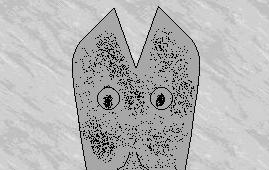Fashion designer. Mother, wife, humanitarian – yeah, yeah, yeah, all that stuff you’re supposed to say when a person dies. The only important thing you need to know is: woman who saved the fashion industry. Born: August 4, 1983, in some hole in the wall city in Bavaria. Died: May 12, 2047, in Paris, Milan and parts of Detroit, of bunion surgery gone horribly, horribly wrong, age 63.
Giorgio Armani’s fate was not funny. Benetton was over and done. Chanel had gone to hell. Christian Dior was no more. Dolce and Gabbana was Dead and Gone. Christian Lacroix was a joke – ha ha. Esprit had no more corpse. Fendi had proven to be a dead endi. Gucci was pooched. Hugo was no longer Boss. Jordache was in ashes. Lancome had gone. Levi Strauss had left the house. L. L. Bean would no longer be seen. Prada was nada. Sonia Rykiel was roadkill. Valentino would be seducing women no more. Versace was scratched. Yves Saint Laurent was no longer au courant.
Fins. As deadly as they can be to swimmers, they were even more deadly to the fashion industry. It wasn’t that everybody’s fall collections had been designed for a body type that largely no longer existed; that had never stopped the major design houses from releasing clothes before. No, the problem was that most of them hastily added slits to designs that they had already developed, usually with disastrous results.
“Jean Paul Gaulthier’s thriving career after his death may come to a halt after his house accidentally electrocuted model Gisele Bundchen,” I wrote at the time. “She was supposed to model a dress that had been designed to look like a Christmas tree, but the slit that was hastily sewn into the dress to accommodate the new fin on her back crossed a few wires, with fatal results.”
Although extreme, this was emblematic of the problems fins posed for modern fashion. Giorgio Armani’s fall men’s line made them look predatory; the only group it was popular with was lawyers. Jordache was accused of both sexualizing and uglifying its models at the same time; its designers froze, confused as to which direction they should follow. Rugged clothing producer Levi Strauss’ hastily constructed finny jean jackets fell apart on runways.
It could have been the end of the fashion industry. Imagine it: people happily making their own clothes. Ewwww urgel burgel! Then, a woman from the little known Schmendrick’s Schmatas House sent designs out that electrified Hoboken, and, soon, the world. They were simple. They were elegant. They accentuated women’s fins in a way that made them look… almost natural.
Me again: “I was totally dispirited when I went to the Annual Hoboken Rag Trade and Cheese Shop Sketch Appreciation Show. With most of the major houses not even trying to put on a show this fall season, I had to go wherever fashion reared its increasingly rare head. And, what a head!
“Stefania Stehaufmannchen of the House of Schmendrick’s Schmatas has gotten it! At last, clothes that accentuate a woman’s fin while flattering it, that treat it like just another beauty choice instead of an insane genetic attack on humanity, that look good on a modern woman’s body!”
Edgerton’s Elysium. Bob and Doug of Paris. Vianni Gervace. None of the fashion dynasties that grew out of the fin debacle would have thrived had it not been for Schmendrick’s Schmatas showing the way.
But, who was Stefania Stehaufmannchen, really? How did she, a relative and absolute unknown, of all the people, manage to solve the fin crisis where so many talented designers failed? Was she a brilliant designer waiting for her moment to take the international stage, or had she just plodded along in mediocrity, rising to fill a vacuum in a historical moment of crisis?
I don’t care. If you want to find out those sorts of…personal details, you can always read one of the many biographies of the woman. I have, of course, read none of them, but I would recommend Hugo Benitsch’s So, You Wanna Make Some Shirts, Maybe Some Pants To Go With Them, A Tie and Some Accessories and Like That, A Nice Girl Like You? It has the longest title, so you know it will likely be quite revealing.
In the meantime, the last word will go, as it should, to me: “Fashion has come back from the brink, my friends. Thanks to Stefania Stehaufmannchen, we have learned our lesson: from now on, every major house will have a design department dedicated to fashion for mutating bodies. Three arms. Four breasts. Six…yes, the possibilities for fashion are once again endless!”
Andre Leon Talley
Andre Leon Talley has been a fashion journalist forever. Well, it feels like forever, anyway.


